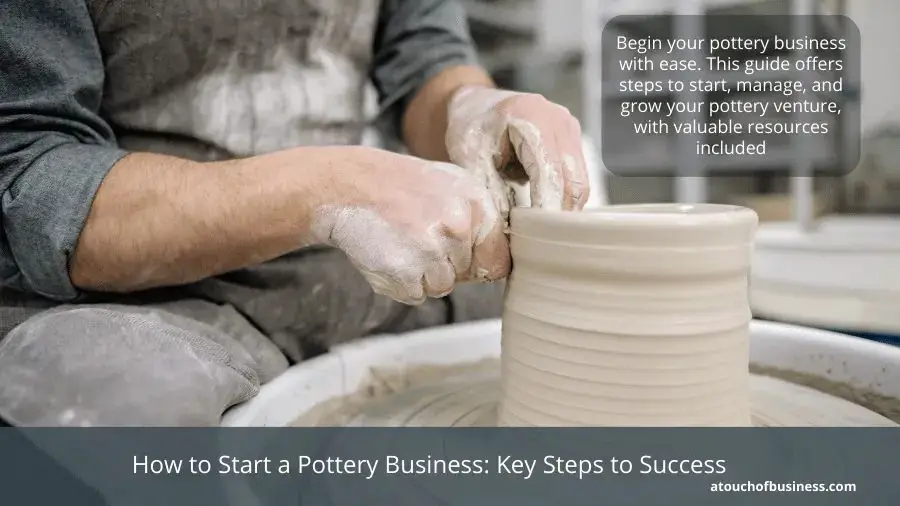Are Pottery Studios Profitable?
Introducing Pottery Studios
A pottery studio is a workspace where artists create functional and decorative ceramic works like bowls, mugs, plates, and sculptures. Studios provide equipment like pottery wheels, kilns, and tools for shaping, firing, and glazing clay (https://en.wikipedia.org/wiki/Studio_pottery). Pottery studios offer classes for all skill levels teaching throwing, handbuilding, sculpture, and glazing techniques (https://studiolaroche.com/products/introduction-to-pottery). Many also have open studio time for independent practice. The types of pottery produced in studios includes tableware, cookware, decorative pieces, tiles, and large scale sculptures. Studios fire work in electric, gas, raku, salt, and wood-burning kilns. Some also offer services like private lessons, camps, parties, gallery space to sell finished wares, and kiln rentals.
Costs of Starting a Pottery Studio
Starting a pottery studio requires significant upfront investment. The main costs include real estate, equipment, materials, advertising, and employees.
For real estate, renting a space suitable for a studio with adequate studio space, classroom space, kiln room, and storage can range from $2,000-$5,000 per month depending on location and size. Buying a property for a studio brings additional expenses like renovations, permits, insurance etc. Source
Equipment like pottery wheels, kilns, slab rollers, extruders etc. can cost between $5,000-$10,000 for a basic professional setup. Ongoing material expenses like clay, glazes, tools, and packaging supplies may cost around $500-$1000 per month depending on studio size and class frequency. Source
Advertising and marketing costs to attract students and promote the studio should be budgeted between $300-$1000 per month. Hiring 1-2 part time employees for assisting with classes, sales etc. at $15 per hour can add $3000-$6000 to monthly costs.
Revenue Streams
Pottery studios generate revenue from multiple sources, with classes and membership fees being two of the largest (Ceramic Income Streams For Studio Potters). Group classes offer steady income, with popular options like wheel throwing, handbuilding, and glazing. Many studios charge $20-$40 per 2 hour group class. Membership fees give access to studio space, equipment, and supplies. Monthly memberships range from $100 for basic access up to $500 for unlimited studio time. Pottery sales are another revenue stream, both from pieces made during classes and works created by studio artists. Marketing and selling pottery online can increase sales. Special events like drink and draw nights and holiday sales attract new customers. Some studios obtain liquor licenses to sell wine, beer, and cocktails during events. Food sales and cafes also complement pottery activities.
Profit Margins
Typical profit margins for pottery studios range from 15-40%, according to industry experts. Profit margins depend on several factors like pricing, costs, and sales volume. Many pottery studio owners aim for profit margins around 15-20% for sustainability according to https://www.pyopaccounting.com. However, some more established studios can achieve margins closer to 40% as noted here. Lower margins around 15% allow for reinvestment in the business, while higher margins provide more profit for the owners.
Profit margins are impacted by the prices charged for classes and products versus the costs of supplies, rent, utilities, marketing and labor. Careful pricing considering costs and local demand is important. Profit margins tend to improve as studios mature, gain customers and operate more efficiently. Effective inventory management and cash flow controls also protect margins. Finding the optimal balance between pricing, costs and sales volume leads to sustainable profit margins for pottery studios.
Keys to Profitability
There are several key factors that can help a pottery studio achieve profitability:
Location is critical – situating the studio in an area with high foot traffic and visibility can drive more walk-in customers. Prime retail space may cost more but can pay off via increased sales. Proximity to affluent neighborhoods is also beneficial.
Finding a profitable niche can boost success. Specializing in high-end art pottery, production pottery, ceramics classes, or paint-your-own pottery provides differentiation. Catering to a specific target market allows focused marketing.1

Making the pottery studio part of a larger retail business or gallery can also improve profitability through combined overhead costs and joint marketing efforts.
Having multiple revenue streams beyond retail sales is key. Offering classes, workshops, private parties, youth programs, and events can generate significant income.2
Challenges
Running a pottery studio comes with many challenges that business owners must contend with. Three of the biggest challenges are the seasonal nature of the business, high overhead costs, and competition from large retailers and big box stores.
Pottery sales tend to fluctuate depending on the time of year, with sales peaking during the winter holiday season and summer months when tourism is high. However, sales tend to decline during the spring and fall. This uneven cash flow can make it difficult for pottery studio owners to pay overhead expenses during slower periods.1
Overhead costs like rent, payroll, utilities, and insurance tend to be high for pottery studios. Pottery studios require extensive space for equipment like wheels, kilns, and storage. They also need adequate ventilation systems to deal with dust and fumes. These high fixed costs eat into profits, especially during seasonal slowdowns.2
Large retailers like Target and Walmart, along with other big box stores, have expanded their home goods sections to include more pottery and ceramics. These stores can leverage economies of scale and buy in high volumes to keep prices low. This makes it challenging for small pottery studios to compete on price.3
Financial Management
To maximize profits, pottery studio owners need sound financial management. This involves carefully controlling costs and optimizing pricing strategies.
On the cost side, pottery studio owners should track expenses closely, including rent, payroll, materials, utilities, maintenance, and more. Buying materials like clay and glazes in bulk can yield discounts. Energy costs can be reduced through energy efficiency measures. Lab testing expenses for glazes and clay bodies can be minimized by mixing and testing carefully in-house first.
Owners should also analyze the costs of each product line or class to understand profit margins. Unprofitable lines may need to be eliminated. Prices should be set strategically – not necessarily based on costs, but what the market can bear.
For maximum profitability, pottery studios need to find the optimal balance between class sizes, frequency, and pricing. Group classes can be more profitable than private lessons if filled. But prices, capacities, and instructor pay should be calibrated carefully based on attendance rates.
Inventory management is another key aspect of financial management for pottery studios. Keeping enough clay, glazes, tools, and other supplies in stock is crucial for smooth operations. But overstocking ties up extra capital unnecessarily. Inventory should be monitored and restocked based on usage rates.
By keeping a close eye on all expenses and optimizing pricing strategies, pottery studio owners can maximize their profit margins and keep their businesses thriving.
Marketing
Social media is a great way for pottery studios to attract new customers and showcase their work. Platforms like Instagram and Facebook allow studios to post images and videos of their latest pieces and behind-the-scenes studio content to a wide audience. Strategic hashtag usage and engaging captions help drive discovery. Studios can also advertise on social media to reach their target demographic and increase followers. Some successful pottery studios get hundreds of thousands of likes on their Instagram posts, attracting new customers who want to purchase their products.
Events like open studio days, exhibitions, and pop-up shops are another great way for pottery studios to market themselves. These events allow the public to come check out the studio, interact with the artists, and purchase items. Partnering with local galleries, shops, cafes and community spaces to display and sell work can also expand a studio’s reach and visibility. Online sales via a studio website and third-party platforms like Etsy provides additional revenue streams. Overall, a multi-channel marketing approach that uses social media, events, partnerships, and e-commerce can substantially increase a pottery studio’s profitability and customer base.
Source: https://www.pinterest.com/ideas/ceramic-studio-branding/961459725669/
Trends
The pottery studio industry has seen some notable trends emerge in recent years. One major trend is the rise of virtual classes and online tutorials. As the pandemic necessitated social distancing, many pottery studios quickly pivoted to offering virtual classes over video chat platforms like Zoom. These virtual classes allow students to participate from the comfort of their own homes. While in-person classes remain popular, the convenience of virtual lessons is likely to make them a permanent fixture at many studios (Markwide Research). Some studios are using a subscription model for their online classes, charging a monthly fee for unlimited access to their virtual class catalog.
Another trend that appears to have staying power is the popularity of pottery painting parties and corporate events at studios. Paint-your-own-pottery studios generate a significant portion of revenue from hosting birthday parties, team building activities, and other special events. Corporate events in particular have become a lucrative source of income, as companies look for unique and engaging ways to boost employee morale and productivity. The high profit margins on corporate events and private parties make them an important trend for pottery studios to focus on (Ibisworld).
The Bottom Line
Overall, starting and operating a profitable pottery studio is certainly achievable with careful planning and execution. While profit margins can vary widely based on business model, location, and target market, most successful studios can achieve 20-30% profit margins or more. Keys to profitability include managing costs efficiently, diversifying revenue streams, effective marketing and promotion, strong financial management, and keeping up with industry trends and innovations. With proper business acumen and passion for the craft, pottery studio owners can build a financially sustainable and personally fulfilling small business in this creative industry.
Sources:

